|
||||||||||||||||||||||||||||||||||||||
Tag: sbpmat
Year-end message from SBPMat’s President.
Dear members of the Brazilian Material Research Society (SBPMat),
This year-end message is, above all else, an appreciation of everyone who has contributed to the major progress of the materials research in Brazil, as well as to SBPMat’s development and strengthening.
2014 was another year of achievements and accomplishments for SBPMat. The event held in João Pessoa was a great proof of that. There were over 2,000 papers registered, with huge attendance rates in all symposia, and a high portion of young researchers and students. The participation was remarkable, both numerically and in terms of quality; the internationalization degree was another highlight of the event. We could not forget to express our gratitude to Professors Iêda Maria Garcia dos Santos and Severino Jackson Guedes de Lima, in recognition for the excellent work they performed by organizing the 2014 SBPMat Meeting.
The release of the document “Science Impact – Materials research in Brazil” was another great achievement for SBPMat in this year of 2014, in addition to the progress of the “University Chapters” program, which has been coordinated by Professor Rodrigo Fernando Bianchi. In these activities, as in all others, there was always the invaluable contribution of the entire SBPMat Directors and Counselors. The success of the SPBMat Newsletter, conducted so efficiently, proves the increasing interest in SBPMat, both in Brazil and abroad.
We wish everyone a Merry Christmas and a 2015 full of accomplishments and success.
Professors Edgar Zanotto and Victor Pandolfelli joined the ranks of the members of the Brazilian National Academy of Engineering.
Professors Edgar Dutra Zanotto and Victor Carlos Pandolfelli, members of the Brazilian Materials research community, were elected to join the ranks of the full members of the Brazilian National Academy of Engineering (ANE) and were sworn, with other 25 engineers, on November 27, 2014, at the Auditorium of the Navy Arsenal in Rio de Janeiro.
By electing full members, ANE honors and recognizes great talents in the professional field by highlighting them as examples and a sources of inspiration for future generations.
Zanotto and Pandolfelli are full Professors of the Materials Engineering Department (DEMa) of the Federal University of São Carlos (UFSCar), Brazil.
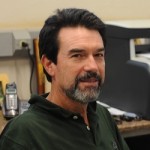
Edgar Zanotto is a Materials Engineer by UFSCar, Master in Physics from the University of São Paulo (USP), Brazil, and PhD in Glass Technology from the University of Sheffield (United Kingdom). At UFSCar, he coordinates the Vitreous Materials Laboratory (LaMaV), established by him in 1977. Amongst many distinctions, he is a Commander of the National Order of Scientific Merit and member of the Brazilian Academy of Sciences (ABC), the World Academy of Ceramics (WAC) and the World Academy of Sciences for the Advancement of Science in Developing Countries (TWAS). In addition to several executive and advisory positions, he is the Director of the Center for Research, Technology and Education in Vitreous Materials (CeRTEVE). Zanotto holds a 1 A-level fellowship for research productivity in the National Council for Scientific and Technological Development (CNPq), and has focused his research work into themes related to glass and glass-ceramics. Zanotto is one of the founders of SBPMat.

Victor Carlos Pandolfelli earned his undergraduate and Master’s degrees in Materials from DEMa – UFSCar, and his PhD in Materials from the University of Leeds (United Kingdom). Pandolfelli is a member of the advisory board of the World Academy of Ceramics (WAC), member of the Brazilian Academy of Sciences and the American Ceramic Society, and visiting Professor of the Wuhan University of Science and Technology (China), to name a few of his many distinctions. He is the Latin-American coordinator of the Federation for International Refractories Research and Education (FIRE), an organization comprising universities in different countries and major companies in the field of refractories. Since 1993, he coordinates the ALCOA (Aluminum Company of Americas) Laboratory at UFSCar. Pandolfelli also holds a 1 A-level fellowship for research productivity in CNPq. Among his main research topics, it is worth mentioning high temperature ceramic materials.
About ANAE
ANE recognizes that the country’s sovereignty, as well as the welfare and security of its population, critically rely on competent, innovative, ethical engineering, concerned about meeting the needs of all segments of society – taking into account the sustainability of the civilization, while based on long term global prospects.
SBPMat newsletter – year 1, issue 11.
|
||||||||||||||||||||||||||||||||||||||||||||||||||||||
20th anniversary of the establishment of the São Carlos Institute of Physics, and six decades participating in the history of Materials research in Brazil.
2014 is a celebration year for one of the protagonist institutions of the history of Materials research in Brazil. The São Carlos Institute of Physics (IFSC), from University of São Paulo (USP), celebrates its 20th anniversary.
However, the origins of IFSC and its contributions to Brazilian Materials Science and Engineering date back to 60 years ago. “From its origins, IFSC had a central role in the development of Materials Science and Engineering, since Materials research was present with the pioneers of IFSC,” says Professor Antonio Carlos Hernandes, IFSC dean from 2010 to 2014 and researcher in the field of Materials.
The beginning of the history can be set in 1953, when USP, which had been founded in 1934, opened a teaching and research facility in the then small city of São Carlos, in the heart of the state of São Paulo. It was the School of Engineering of São Carlos (EESC), which exists to the present. At the time, the dean of the school, Theodoreto Souto, mandated to form a team of lecturers and researchers, recruited professors to São Carlos, mainly in São Paulo (USP), in Rio de Janeiro and abroad, but failed for them to settle in town for long.
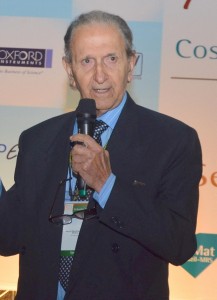
From Rio de Janeiro, the first to integrate the EESC professors’ team was physicist Armando Dias Tavares, assistant of Joaquim da Costa Ribeiro in the Physics laboratories of the National School of Philosophy of the University of Rio de Janeiro (now Federal University of Rio de Janeiro, UFRJ). Then, collaborators and students of Dias Tavares, who had learned to do science in the “school” of Costa Ribeiro and Bernhard Gross (main pioneers of Materials research in Brazil) left the “marvelous city” to the inland of São Paulo, invited by Souto. Among them, the newly graduated in Physics and Chemistry and honeymooners Sergio Mascarenhas Oliveira and Yvonne Primerano Mascarenhas – a couple who leaved an important legacy in the history of Materials Science and Engineering in the region and in the country – arrived in São Carlos in 1956.
At a time when most of the human and material resources for research in Physics, in the world and in Brazil, were intended for Nuclear and High Energy Physics, the Mascarenhas couple chose to start studies in Condensed Matter Physics, field they had worked with Costa Ribeiro in Rio de Janeiro. Documents prepared by IFSC state that Sergio and Yvonne saw two possibilities in that area for the group of São Carlos: to internationally stand out in a field where there was less competition, and to generate applications that had a positive impact on the region’s economy and quality of life of its population.
Thus, in the 1960s, Sergio Mascarenhas created the Condensed Matter Physics Group. “Thanks to a very strong exchange between USP in Sao Carlos, and the universities of Princeton and Carnegie Mellon in the United States, and also groups from England and Germany, mainly in Stuttgart, we managed to establish a very intense research training program, which continues to this day”, Mascarenhas commented in an interview granted in 2013 to the SBPMat Newsletter. Among the works with the greatest impact conducted at the time by the São Carlos group, it is possible to mention research related to defects in crystals, such as ionic crystals with a color core, which were later used for optical memories.
In the late 1960s, a new teaching and research institution, the Federal University of São Carlos (USFCar), was created in town, with the effective participation of professors of the EESC group. In particular, Sergio Mascarenhas, who was the first dean (pro tempore) of the university, proposed the creation of the first graduate course in Materials Engineering in Latin America, seeking to build a bridge between Materials Science and the generation of products, processes and services. The course started its activities in 1970.
In another pioneering initiative in the Materials field, the São Carlos group, with Sergio Mascarenhas as head of the organization, hosted the Brazilian community of solid state physicists (then consisting of about 50 researchers) in town to conduct the “First National Symposium on Solid State Physics and Materials Science “in a small shed.
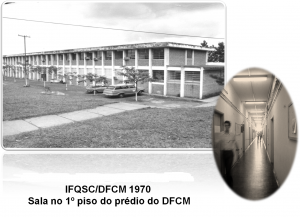
As a result of the growth, institutionalization and gain of autonomy trodden by Mascarenhas and colleagues of the São Carlos group, in 1971 the Institute of Physics and Chemistry of São Carlos (IFQSC) was created, and the first dean was Mascarenhas himself. IFQSC had from its very beginning a Department of Physics and Materials Science, and a Department of Chemistry and Molecular Physics. Another step was taken in 1994 when IFSC was dismembered, giving rise to the Institute of Chemistry of São Carlos (IQSC) and IFSC, whose first dean was Yvonne Primerano Mascarenhas.
Another milestone in the part of IFSC in the history of Materials research in Brazil was the creation, in 1993, of the inter-unit program in Materials Science and Engineering at USP São Carlos. Managed by IFSC, the program brings together professors of this Institute, IQSC and EESC, as well as researchers from other institutions in the region.
Action with academic and social impact
Besides participating in the inter-unit program, IFSC has one of the most acknowledged and applied postgraduate programs in Physics in the country, which has obtained, since its creation, full marks in assessments from the Federal Agency for the Support and Evaluation of Graduate Education (CAPES). Within its master’s and doctorate, it is possible to perform research in a wide range of topics, including several possibilities in the Materials field, from fundamental research in Condensed Matter Physics to studies on semiconductor materials, polymers, ceramics and glass. Also in the Materials field, IFSC currently has consolidated research groups, for example, the Polymer Group of “Professor Bernhard Gross,” and is home to large projects such as National Institutes of Science and Technology (INCTs) and Research, Innovation and Dissemination Centers.
However, the impact of academic performance of the São Carlos group in the Materials field has exceeded the limits of the city of São Carlos. According to Professor Antonio Carlos Hernandes, the first consequence of this performance was the graduation of doctors (PhD) who began to operate in such field in other higher education institutions. “Thus, many university and research centers operating in Materials today have the IFSC training on their DNA”, says Hernandez.
“IFSC brings together what is essential to the quality of Materials research, with equipment and people with experience in various types of materials,” says Professor Osvaldo Novais de Oliveira Junior, deputy dean of IFSC for the period 2012- 2016. Relying on these features, Novais adds, hundreds of masters and doctors graduated in Materials, many of which have become leaders of research groups in all regions of Brazil. “These leaders of various institutions, as well as others who are part of IFSC, currently play an important role in organizing the Materials community in the country, acting in the Brazilian Materials Research Society (SBPMat), coordinating events and national and international cooperation programs, and formulating public policies”, he adds.
But the impact of IFSC’s performance in the Materials field goes beyond the academic environment. Professor Hernandes highlights, among other examples, the creation of technology-based companies located in the city of São Carlos. “These high-tech companies originated from IFSC researchers work, often involving Materials research”, professor Novais states, which also brings up another type of social contribution made by professors and researchers of the institute, the “tireless work of popularization of science, with various programs for students of primary and secondary education, as well as for the general public. “
Biomaterials in event hold by UC from Bauru.
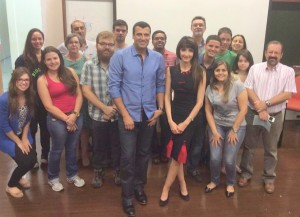
The University Chapter Biomaterials (UCB), headquartered in Bauru (city in the state of Sao Paulo) held its seventh monthly meeting in the morning of November 19th, in the São Paulo State University (UNESP). In that occasion, two foreign researchers who were in Bauru delivered seminars in the meeting.
Professor Ana Maria Pires Pinto from Universidade de Minho (Portugal) lectured about new concepts for biomedical applications of metallic matrix composites. Next, nanomedicine in situ was the topic of the seminar given by professor Tolou Shokuhfar, from Michigan Technological University (U.S.A.).
“The researchers were in contact with our group and we were highly complimented by them”, says Diego Rafael Nespeque Correa, president of UCB and PhD Researcher in the UNESP Post-graduate program in Materials Science and Technology. “We managed to maintain an environment of substantial scientific discussions and promotion of our group”, he adds.
UCB is of the five current units of the SBPMat University Chapters Program.
UCB Facebook: https://www.facebook.com/
About SBPMat University Chapters Progran: http://sbpmat.org.br/en/university-chapters/
First SBPMat UC from the south of Brazil.
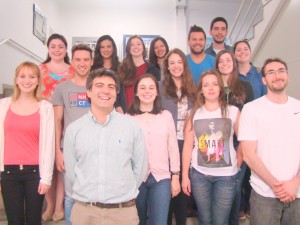
The SBPMat University Chapters program has its first unit in Rio Grande do Sul, since the end of October 2014. Headquartered in the University of Caxias do Sul (UCS), this UC has 14 participants, who are connected to UCS, the Federal University of Santa Maria (UFSM), and the Federal University of Rio Grande do Sul (UFRGS).
“What motivated me and all who are part of our UC was the possibility to generate other partnerships and add valuable knowledge”, says Bruna Louise Perotti, president of the UC, Mechanical Engineering student and scientific initiation fellow connected to the UCS Post-graduate program in Engineering and Materials Science. The group has plans for the next semester: organize lectures and seminars (initially with local lecturers and afterwards with visiting lecturers) and carry out scientific events to promote the interaction and collaboration between contributing research groups, generating innovation in the assignments, andfinally contribute to promote them.
SBPMat newsletter. English edition. Year 1, issue 10.
|
||||||||||||||||||||||||||||||||||||||
XIII SBPMat Meeting simposia: statements of the coordinators.
In approximately one minute, some coordinators share their impressions about their symposia.
A: Functional hybrid interfaces: from characterization to applications. Welchy Leite Cavalcanti (IFAM – Alemanha).
B: Ceramic and metallic materials obtained by wet-chemical methods. Mary Alves (UEPB).
C: Magnetic Materials. Marcos Flavio de Campos (UFF).
D: Organic Electronics and hybrids: materials and devices. Ivan H. Bechtold (UFSC).
E: Sol-Gel Materials: From Fundamentals to Advanced Applications. Andrea S. de Camargo (USP São Carlos).
F: Anti-fouling Materials and Coatings. Mônica de Oliveira Penna (PETROBRAS).
G: Research Frontiers of Computer Simulations in Materials Science: Developments and Applications. Miguel San-Miguel (University of Sevilla, Espanha).
H: Luminescent Materials. Hermi F. Brito (USP).
J: IX Brazilian Electroceramics Symposium. Marcelo Ornaghi Orlandi (UNESP).
K: Structure-Properties Relationship of Advanced Metallic Materials. Leonardo Barbosa Godefroid (UFOP).
L: Current Research in Energy Storage Systems. Alexandre Urbano (UEL).
M: Nanomaterials for Nanomedicine. Carlos Jacinto da Silva (UFAL).
N: Surface Engineering – functional coatings and modified surfaces. Carlos Alejandro Figueroa (UCS e Plasmar Tecnologia).
O: Multifunctional materials derived from clay minerals. Maria Gardênnia da Fonseca (UFPB) e Maguy Jaber (Université Pierre et Marie Curie, França).
P: Advanced Carbon Nanostructures and Composites. Jilian Nei de Freitas e Talita Mazon (Centro de Tecnologia da Informação Renato Archer)
Q: International Symposium on Cementitious Materials – ISCM2014. Sandro Torres (UFPB).
R: Innovation and Technology Transfer Symposium. Rodrigo Bianchi (UFOP).
SBPMat in partnership with IOP presents to the world a broad overview of the field of materials in Brazil.
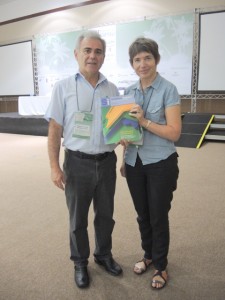
The XIII SBPMat Meeting was the context chosen for the launch of a publication on the current overview of materials research in Brazil, prepared by the IOP (Institute of Physics) Publishing for SBPMat. The report was distributed to all participants who picked up their material at the meeting – over 1,600. Furthermore, the IOP stand at the exhibitors´ area distributed the document throughout the event. Also, SBPMat is working on sending the publication to university libraries, funding agencies and other entities in Brazil and overseas. The digital version of the document is available on the web.
UK physicists Susan Curtis and Michael Blanks, who work as reporters and editors in IOP magazines, visited about 20 Brazilian institutions to prepare the report. The duo interviewed more than 50 scientists, including researchers working in the field of materials, leaders of the Brazilian scientific policy and coordinators from laboratories, research centers, projects and institutes. A highlight was given to interviews with two important foreign scientists in the field, who spoke about the Brazilian overview and other topics: the 2013 presidents of the Materials Research Societies in Europe (E-MRS) and the United States (MRS), Portuguese Rodrigo Martins and Argentinian-born Orlando Auciello, respectively.
The result was a magazine format document, titled “Science impact. A special report on materials science in Brazil”, composed by 14 reports and interviews, along with the introduction signed by the SBPMat president, Professor Roberto Mendonça Faria.
Brazil shows that materials matter
The report shows a very positive evolution in materials research carried out in Brazil since the beginning of this century, resulting from increasing public investments and strategies from federal and state entities to support postgraduate education, research and innovation, among other reasons.
In its 42 pages, the report discusses recent results of research conducted in Brazil on topics such as carbon nanomaterials, materials with applications in health, research aimed at improving the performance of materials used in various industries, materials for more efficient and cheaper optoelectronic and photonic devices and systems, natural materials optimized by research, and materials to produce and store solar energy.
In addition, Curtis and Blank mapped the open laboratories in Brazil in the field of materials, which share their equipment to users in academia and industry from the country and abroad. They also reported, throughout the document, numerous cases of transfer of knowledge and technology from the university to the industry through the creation of spinoff companies and through projects with large companies such as Camargo Correa, Embraco, Petrobras and Vale. Interesting pieces of information on the history of Materials Science in Brazil complement the publication.
About the duo of physicist-journalists
Michael Blanks is news editor at IOP´s Physics World magazine. During his graduation in physics at Loughborough University he spent a year at Max Planck Institute for Solid State Research in Stuttgart (Germany). He began working at IOP in 2007, after finishing his PhD in experimental condensed matter physics.
Susan Curtis has nearly two decades of experience in publishing and editing science magazines and websites at IOP. She graduated in physics from the University of Surrey and has been a researcher at the company BP.
Link to the digital version of the document: http://mag.digitalpc.co.uk/fvx/iop/scienceimpact/BMRS2014/
